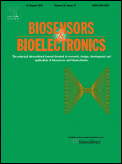Citation: Kannan Balasubramanian, Biosensors and Bioelectronics (2010), 26, 4, 1195-1204.
Summary: This review outlines the use of one-dimensional nanostructures (1D-NS) for the detection of biomolecules on a chip. The materials discussed here include carbon nanotubes, metallic and semiconducting nanowires and nanochannels. While nanotubes and naowires have predominantly been used as electrical detectors, nanochannels are promising frameworks for optical detection in applications such as separation, preconcentration and DNA mapping. The primary expectation for all the three types of 1D-NS lies in the promise for ultimate single molecule detection. Furthermore, the electrical double layer governs the physics behind biosensing in all the three systems. The review starts by shedding light on the advantages arising due to the use of 1D nanostructures, followed by a discussion of fundamental aspects such as double layer effects and sensing methodologies. After this, the three kinds of 1D-NS are introduced. The main focus of the review is an in-depth analysis of the current achievements in the field and the major challenges that are to be overcome for the widespread use of such nanostructures in applications such as lab-on-a-chip devices and point-of-care diagnostics.
